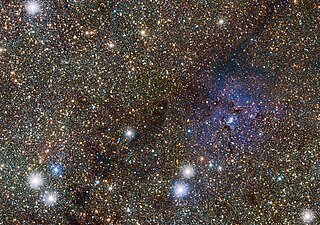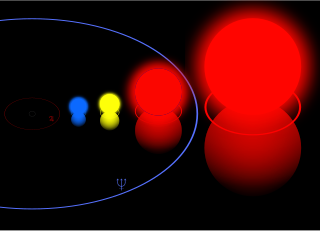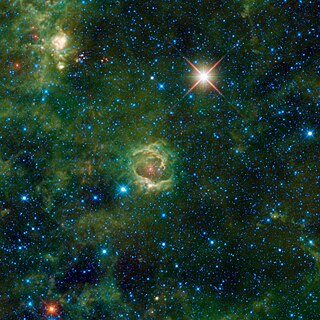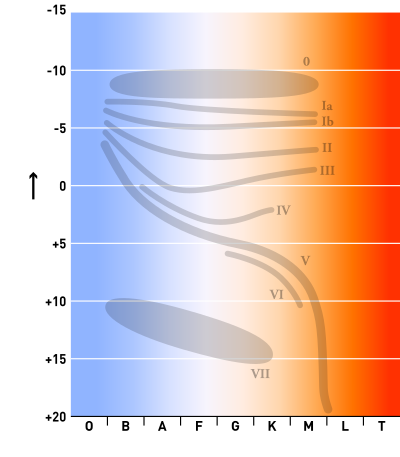
A variable star is a star whose brightness as seen from Earth fluctuates.

Supergiants are among the most massive and most luminous stars. Supergiant stars occupy the top region of the Hertzsprung–Russell diagram with absolute visual magnitudes between about −3 and −8. The temperature range of supergiant stars spans from about 3,400 K to over 20,000 K.

Red supergiants (RSGs) are stars with a supergiant luminosity class of spectral type K or M. They are the largest stars in the universe in terms of volume, although they are not the most massive or luminous. Betelgeuse and Antares are the brightest and best known red supergiants (RSGs), indeed the only first magnitude red supergiant stars.

In astronomy, a blue giant is a hot star with a luminosity class of III (giant) or II. In the standard Hertzsprung–Russell diagram, these stars lie above and to the right of the main sequence.

A blue supergiant (BSG) is a hot, luminous star, often referred to as an OB supergiant. They have luminosity class I and spectral class B9 or earlier.

A giant star is a star with substantially larger radius and luminosity than a main-sequence star of the same surface temperature. They lie above the main sequence on the Hertzsprung–Russell diagram and correspond to luminosity classes II and III. The terms giant and dwarf were coined for stars of quite different luminosity despite similar temperature or spectral type by Ejnar Hertzsprung about 1905.

The red-giant branch (RGB), sometimes called the first giant branch, is the portion of the giant branch before helium ignition occurs in the course of stellar evolution. It is a stage that follows the main sequence for low- to intermediate-mass stars. Red-giant-branch stars have an inert helium core surrounded by a shell of hydrogen fusing via the CNO cycle. They are K- and M-class stars much larger and more luminous than main-sequence stars of the same temperature.

RV Tauri variables are luminous variable stars that have distinctive light variations with alternating deep and shallow minima.
Alpha Cygni variables are variable stars which exhibit non-radial pulsations, meaning that some portions of the stellar surface are contracting at the same time other parts expand. They are supergiant stars of spectral types B or A. Variations in brightness on the order of 0.1 magnitudes are associated with the pulsations, which often seem irregular, due to beating of multiple pulsation periods. The pulsations typically have periods of several days to several weeks.

A yellow hypergiant (YHG) is a massive star with an extended atmosphere, a spectral class from A to K, and, starting with an initial mass of about 20–60 solar masses, has lost as much as half that mass. They are amongst the most visually luminous stars, with absolute magnitude (MV) around −9, but also one of the rarest, with just 15 known in the Milky Way and six of those in just a single cluster. They are sometimes referred to as cool hypergiants in comparison with O- and B-type stars, and sometimes as warm hypergiants in comparison with red supergiants.

The unqualified term instability strip usually refers to a region of the Hertzsprung–Russell diagram largely occupied by several related classes of pulsating variable stars: Delta Scuti variables, SX Phoenicis variables, and rapidly oscillating Ap stars (roAps) near the main sequence; RR Lyrae variables where it intersects the horizontal branch; and the Cepheid variables where it crosses the supergiants.

A hypergiant (luminosity class 0 or Ia+) is a very rare type of star that has an extremely high luminosity, mass, size and mass loss because of its extreme stellar winds. The term hypergiant is defined as luminosity class 0 (zero) in the MKK system. However, this is rarely seen in the literature or in published spectral classifications, except for specific well-defined groups such as the yellow hypergiants, RSG (red supergiants), or blue B(e) supergiants with emission spectra. More commonly, hypergiants are classed as Ia-0 or Ia+, but red supergiants are rarely assigned these spectral classifications. Astronomers are interested in these stars because they relate to understanding stellar evolution, especially with star formation, stability, and their expected demise as supernovae.

Classical Cepheids are a type of Cepheid variable star. They are population I variable stars that exhibit regular radial pulsations with periods of a few days to a few weeks and visual amplitudes from a few tenths of a magnitude to about 2 magnitudes.

TZ Cassiopeaie(TZ Cas, HIP 117763, SAO 20912) is a variable star in the constellation Cassiopeia with an apparent magnitude of around +9 to +10. It is approximately 8,000 light-years away from Earth. The star is a red supergiant star with a spectral type of M3 and a temperature below 4000 Kelvin.

PZ Cassiopeiae is a red supergiant star located in the Cassiopeia constellation, and a semi-regular variable star.

An O-type star is a hot, blue-white star of spectral type O in the Yerkes classification system employed by astronomers. They have temperatures in excess of 30,000 kelvin (K). Stars of this type have strong absorption lines of ionised helium, strong lines of other ionised elements, and hydrogen and neutral helium lines weaker than spectral type B.

UY Scuti (BD-12°5055) is a red supergiant star in the constellation Scutum. It is considered one of the largest known stars by radius and is also a pulsating variable star, with a maximum brightness of magnitude 8.29 and a minimum of magnitude 10.56. It has an estimated radius of 1,708 solar radii (1.188×109 kilometres; 7.94 astronomical units), thus a volume nearly 5 billion times that of the Sun. It is approximately 2.9 kiloparsecs (9,500 light-years) from Earth. If placed at the center of the Solar System, its photosphere would at least engulf the orbit of Jupiter.

14 Persei is a single star in the northern constellation Perseus, located roughly 1,900 light years away from the Sun. It is visible to the naked eye as a faint, yellow-hued star with an apparent visual magnitude is 5.43. The object is slowly moving closer to the Earth with a heliocentric radial velocity of −1.2 km/s.
R Sagittae is an RV Tauri variable star in the constellation Sagitta that varies from magnitude 8.0 to 10.5 in 70.77 days. It is a post-AGB low mass yellow supergiant that varies between spectral types G0Ib and G8Ib as it pulsates. Its variable star designation of "R" indicates that it was the first star discovered to be variable in the constellation. It was discovered in 1859 by Joseph Baxendell, though classified as a semi regular variable until RV Tauri variables were identified as a distinct class in 1905.

In the field of stellar evolution, a blue loop is a stage in the life of an evolved star where it changes from a cool star to a hotter one before cooling again. The name derives from the shape of the evolutionary track on a Hertzsprung–Russell diagram which forms a loop towards the blue side of the diagram.
















